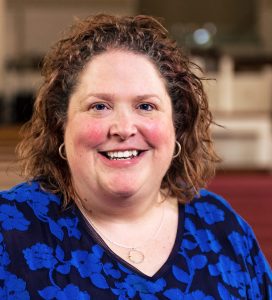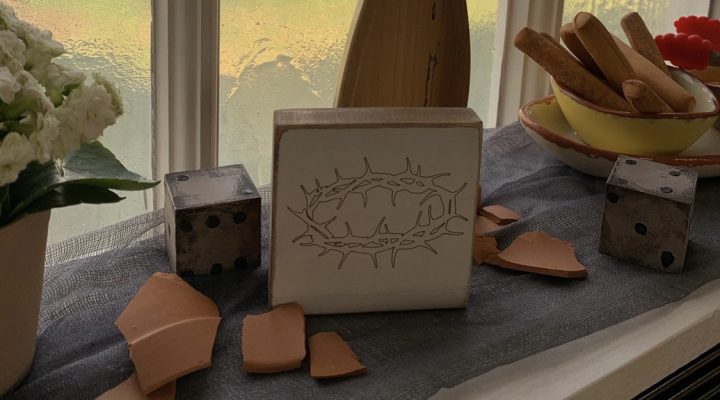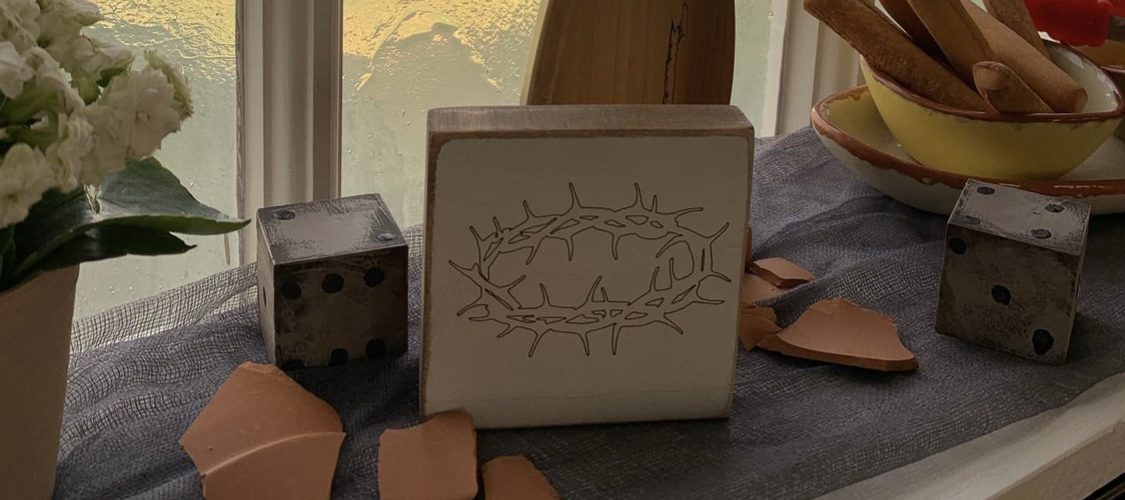The sanctuary is still and the lights are out. The afternoon sunlight filters in through the ample windows along each side of the church. Every few minutes someone enters quietly and begins the journey of these seven stations.
This has been our church’s longstanding practice for Holy Week, but the lessons learned here may carry well beyond Easter Sunday. There are calls to prayer all around us, if we have eyes to see them.
During Holy Week, what we offer isn’t the traditional Stations of the Cross. These are really just our own little version. But don’t tell anyone. We don’t know any better. We’re Baptists!

Eli Withers
We set up something like prayer stations in the windows around the sanctuary with the final station on the Communion table in the front of the sanctuary.
On our first attempt, we strongly considered some kind of soft, reflective music playing in the background but ended up having no music and embraced the stillness of an empty sanctuary. That remains our practice today.
Each year, our stations look a bit different than the year before, but we’ve begun to settle into our own rhythm using a variety of handmade crosses, vases, old church windows and other more decorative items to add an element of tradition in a modern-looking building. Each station is filled with items reflective of the prayer practice encouraged: a perfume bottle, doves or silver coins, for example.
Upon entering the sanctuary, a participant encounters the first station as an introduction to the journey. Last year, we considered several ways we had experienced the broken places of our world. There were globes of various sizes in the window, and we were asked to find Ukraine on one of the globes. Then we placed a finger on that globe while offering our prayers for God’s grace and intervention in the (still) current war with Russia.
This year, we focused specifically on what our journey looked like from Ash Wednesday through to Holy Week. We had three small bowls of ashes left over from the Ash Wednesday service. Scrap pieces of paper were taped to the windows, and we were encouraged to put our fingers in the ashes and make our marks on the paper provided while considering how finite our time on this earth is.
Each year, we work to make sure these stations are for all ages so families can walk them together and understand the message. Thus, at the first station this year, parents encouraged children to make their own ash marks, reminding them of how God calls each of us to make our mark on the world.
“We work to make sure these stations are for all ages so families can walk them together and understand the message.”
The journey continued around the sanctuary as we marked the specific days of Holy Week as well as other significant events that occurred prior to the Crucifixion. Among a donkey, some palm leaves and a few scattered pieces of fabric were some paper hands in a variety of colors. Here, we were encouraged to write on the hands our own words of praise for Jesus. When finished, we taped our hands to the window. As each person passed through the station, more and more hands were lifted in praise together.
In past years, we have had stations focusing on Jesus washing the disciples’ feet. In particular, we compared what it meant to wash someone’s feet or considered cultures that even today wash the hands of a guest as you share a meal together. We included a sweet-smelling hand sanitizer to help us imagine the gift of serving others in the way Christ taught us to serve — even amid the COVID pandemic.
We also have provided elements of the Lord’s Supper to encourage folks to sit in quiet and savor the time spent just holding the elements in their hands while reading Scripture, praying or simply having some intentional time in the quiet sanctuary.
A favorite station from some years ago focused on a cross about 4 feet tall created by one of our church members. At the Maundy Thursday service the night before, we pounded nails in that cross to symbolize our own sin and brokenness. On Good Friday, we came to that cross as the last station and considered all Jesus had done for us as he gave his life. We acknowledged the healing and restoration that comes to each of us through the Cross, and as we did, we took pieces of white ribbon and tied them around the cross to help us remember that holy day.
 Our last station this year — which of course focuses on death and resurrection — included small brown journals, markers, pens and colored pencils scattered about our large wooden cross, amid chalices of various sizes and colors, candles and a crown of thorns.
Our last station this year — which of course focuses on death and resurrection — included small brown journals, markers, pens and colored pencils scattered about our large wooden cross, amid chalices of various sizes and colors, candles and a crown of thorns.
At each station there was a framed poem, blessing or prayer to compliment the Scripture for that station. But at this final station, participants picked up one of the blank journals and a few markers or pens and found a personal space in the sanctuary a bit out of the way from the stations. There we were invited to write, draw or color our own poems, prayers or blessings, as well as listen to God’s whisper in our ear.
Here, we allowed ourselves the time of reflection as long as we needed it in a welcoming and worshipful space. When we were ready, we walked out the center aisle to exit, bringing our journals with us for further reflection. Just as we reached the doors in the back of the sanctuary, there was a Holy Saturday prayer offered for us to take with us.
Holy Week and Easter Sunday are now passed for this year, but consider how you might create similar opportunities at other times for specific and intentional prayer.
In these several weeks after Easter, the season of Eastertide, we should continue to seek out opportunities for unique prayer experiences. This is another way we might practice resurrection. We can find our own stations for prayer and reflection as throughout the spring, the whole earth is showing us resurrection at every turn. We just need to pay attention.
“Give yourself time to take a leisurely walk around town or somewhere further into nature.”
So this week, give yourself time to take a leisurely walk around town or somewhere further into nature. Maybe a park, your neighborhood or a peaceful community garden. Find a comfy place to sit and read Scripture or a favorite book. Bring a friend or family member or just go by yourself. Look around everywhere and see what you can discover.
Hop in the car and take an adventure, stopping along the way to take photos of the beautiful places you see resurrection in our world. Share your photos with someone who will appreciate them. Post them on social media to invite others to watch as resurrection reaches out all around us. Write down Scripture passages that come to mind. Reach out to a friend you haven’t seen or talked to in quite a while. Enjoy lunch together or just give them a phone call.
As it turns out, the world God has created for us already is full of prayer stations and kneeling places. It is truly stunning when we come across a field of wildflowers that no one intentionally planted or designed, but there they are nonetheless. We are being invited into a closer relationship with our God every moment of every day.
Remember in The Color Purple by Alice Walker when Shug says to Celie, “More than anything God loves admiration.”
Celie responds, “You saying God is vain?”
“No, not vain, just wanting to share a good thing. I think it pisses God off when you walk by the color purple in a field and don’t notice it.”
This Eastertide, let’s look for all God’s good things. Let’s help one another see the color purple peeking out along our way. And for purple, and for every other color, we say thanks be to God.
Eli Withers serves as associate pastor of Harrisonburg Baptist Church in the Shenandoah Valley region of Virginia. She enjoys watching movies, reading books, playing with art and being outside – especially wherever there are wildflowers.


